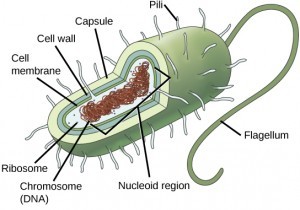Prokaryotic and eukaryotic cells represent the two fundamental cell types found in living organisms. While both share certain core features like a plasma membrane, cytoplasm, DNA, and ribosomes, a typical prokaryotic cell is significantly simpler and smaller than a eukaryotic cell. The key distinction lies in the presence or absence of a membrane-bound nucleus and other organelles. This article will delve into the critical differences between these two cell types.
Lack of a Nucleus and Membrane-Bound Organelles Defines Prokaryotic Cells
A typical prokaryotic cell lacks a nucleus, the defining feature of eukaryotic cells. Instead of a nucleus, prokaryotic DNA is concentrated in a region called the nucleoid. This region isn’t enclosed by a membrane, meaning the genetic material directly interacts with the cytoplasm.
Furthermore, prokaryotic cells lack other membrane-bound organelles such as mitochondria, endoplasmic reticulum, Golgi apparatus, and lysosomes, all of which are common in eukaryotic cells. These organelles compartmentalize various cellular functions in eukaryotes, leading to greater complexity and efficiency. Prokaryotes, lacking this compartmentalization, carry out all their cellular processes within the cytoplasm.
Prokaryotic cells, however, do possess a cell wall composed of peptidoglycan (in bacteria) or other materials (in archaea). This wall provides structural support, helps maintain cell shape, and offers protection against osmotic stress. Many prokaryotes also have a capsule, a sticky outer layer that aids in attachment to surfaces and provides additional protection. Some possess flagella for movement and pili for genetic exchange (conjugation) or attachment.
Eukaryotic Cells: Defined by Complexity and Compartmentalization
In stark contrast, a typical eukaryotic cell is characterized by its membrane-bound nucleus which houses the cell’s DNA. This physical separation of genetic material from the cytoplasm allows for more intricate regulation of gene expression.
Beyond the nucleus, eukaryotic cells contain a variety of membrane-bound organelles, each specialized for specific tasks. Mitochondria generate energy through cellular respiration, the endoplasmic reticulum synthesizes proteins and lipids, the Golgi apparatus modifies and packages proteins, and lysosomes break down cellular waste. This compartmentalization enables eukaryotic cells to perform complex metabolic processes and achieve a higher level of organization.
Size Matters: A Significant Difference
Prokaryotic cells are considerably smaller than eukaryotic cells. Typically ranging from 0.1 to 5.0 micrometers (µm) in diameter, they are dwarfed by eukaryotic cells, which measure between 10 and 100 µm. This size difference reflects the greater complexity and functional capacity of eukaryotic cells. The smaller size of prokaryotes facilitates rapid diffusion of nutrients and waste products across their cell membrane, while eukaryotic cells have evolved intricate transport mechanisms to overcome the challenges posed by their larger size.
Summary: Prokaryotic vs. Eukaryotic Cells
In summary, a typical prokaryotic cell is significantly less complex than a eukaryotic cell. It lacks a true nucleus and other membrane-bound organelles, is smaller in size, and has a simpler overall structure. Eukaryotic cells, with their membrane-bound nucleus and organelles, demonstrate a higher degree of organization and specialization, allowing for greater complexity in structure and function. This fundamental difference in cellular architecture reflects the vast diversity of life on Earth.


